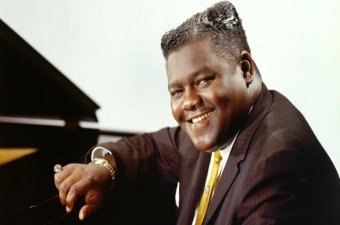The Hideaway
2800 Desire PkwyNew Orleans LA 70126
The Hideaway was a little rhythm and blues club in the upper Ninth Ward where the legendary Antoine “Fats” Domino was discovered in late 1949. He began playing there regularly early that year and continued into early 1950, developing his rocking sound launching a recording career that changed popular music worldwide.
The proprietors of the Hideaway, Jessie Lee Wells and Edwin Compass, saw Domino play piano as an unknown sideman in the magnificent Club Desire, and asked him to “star” at their dive bar two blocks down the street. The Hideaway was named for good reason: to find it, customers had to walk past railroad tracks and an area overgrown with vegetation. Inside, mismatched chairs clustered around old wooden tables hidden under tablecloths; tattered drink signs decorated the walls, and dusty crepe paper streamers hung from the ceiling.
Domino wasn’t making much money at the time and had a newborn at home, so he took the gig despite his fears—he’d never formally led a band. With the help of his brother-in-law Harrison Verrett, a guitarist/banjoist in Papa Celestin’s band, and his cousin Freddie Domino, a trumpeter and bandleader, Domino put together a group with Freddie’s sax players Charles Burbank and Hiram Armstrong, and another brother-in-law, Robert Stevens, on drums.
Domino was a very shy 20-year-old, still living in a room with his in-laws. To take center stage, he needed a venue where folks didn’t act or dress too fancy, where a raw beat was welcome and he could build up his confidence on sweaty weekend nights. When Domino sat at the upright piano on the small bandstand, you could hear the pounding for blocks. “It was a lot of fun,” he recalled. “I used to be waiting for those three nights a week.”
Domino played into the wee hours, building up to a rumbling locomotive piano sound on the New Orleans blues standard “The Junker’s Blues” and ripping an amphetamined “Swanee River Boogie”— his two crowd killers. The sax players circled the dance floor, ran through the crowd, and kept playing as they jumped up on the bar or on tables. Stevens sometimes beat his drums with gourds. They all stood at the end for dramatic finales.
By the summer of 1949 Domino’s manic gigs at the Hideaway began attracting a crowd. Vernon Winslow, who had become New Orleans’ historic first black disc jockey “Dr. Daddy-O” in late May, wrote the first big praise of the pianist in his July 9th Louisiana Weekly column: “Fats Domio [sic] is making ‘em shout and holler!!!”
The most notable visitors came one night in early December: Dave Bartholomew, New Orleans’ top bandleader; Henry “Duke” Thiele, the hugely popular white rhythm and blues disc jockey known as Poppa Stoppa; Al Young, owner of the Bop Shop; and Lew Chudd, owner of Imperial Records, who’d come all the way from Hollywood to record New Orleans talent. Bartholomew wasn’t smitten with Domino’s style, but Chudd, a big boogie woogie piano fan, was thrilled, particularly by “The Junker’s Blues.”
Chudd assigned Bartholomew to record the song with Domino and flew back to L.A. Bartholomew had trouble turning the junker drug anthem into a mainstream song until he was inspired by the detective radio show The Fat Man to rewrite the lyrics, connecting them to Domino’s nickname: They call me a junker became They call me the Fat Man. On December 10th Domino went to J&M Studio to cut the song with Bartholomew and his all-star band. Domino’s driving piano and youthful Creole voice (including wah wah wails) led the way in making “The Fat Man” a big national hit in early 1950.
Bartholomew’s commercial sensibilities and prowess as an arranger made him a perfect partner for Domino. Their shared obsession with heavy rhythm would help upend the popular music of the day, which, after the death of big bands, was drowning in balladry and novelty (“The Fat Man” is considered by some to be the first rock ‘n’ roll record). Together, they’d crank out a historic string of hits, selling tens of millions of records.
In late March Domino reluctantly went on tour with Bartholomew’s band — all the way to California, leaving behind his beloved weekends at the Hideaway, which he memorialized in the recording “Hideaway Blues.” The great blues guitarist Smiley Lewis played the Hideaway later in 1950, but the club hosted few other musicians. It was mostly just a bar, which was torn down a few years later to make way for the Desire public housing complex.
For more on the roots of rock ‘n’ roll in New Orleans click here.
Videos

From WWOZ's Tricentennial Music Moments: a short video about Fats Domino's big break at the Hideaway.
Video by WWOZ.
From WWOZ's Tricentennial Music Moments: a short video about Fats Domino's big break at the Hideaway.

Dave Bartholomew and Herbert Hardesty recall their work with Fats Domino at the 2009 Ponderosa Stomp History Conference.
Video by The Ponderosa Stomp.
Dave Bartholomew and Herbert Hardesty recall their work with Fats Domino at the 2009 Ponderosa Stomp History Conference.
Images








